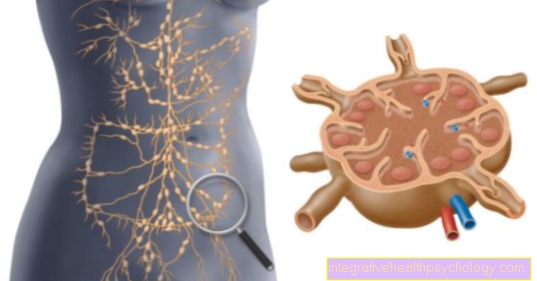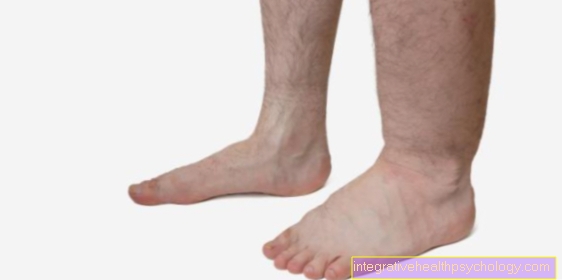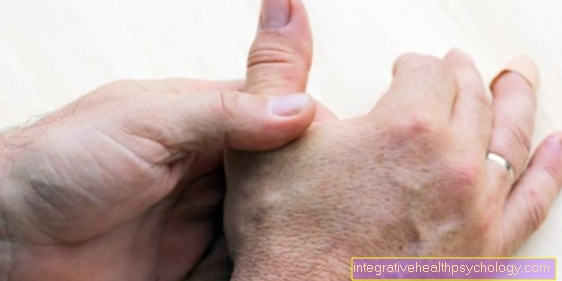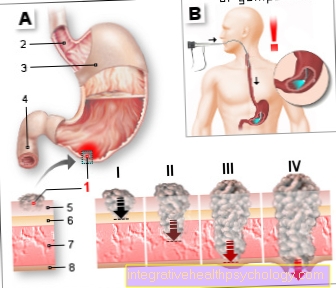Calcified heart valve
definition
Heart valves are mechanical, functional closures between the atria, heart chambers and large conduction pathways. They open as part of the heart's pumping cycle to move the blood in a targeted direction. As in every body vessel, deposits can form in the area of the heart valves and narrow them. Colloquially, one speaks of lime and finally a calcified heart valve. A calcified heart valve is narrowed and can therefore function less well. One consequence is that the blood flow is disturbed and the body can no longer be adequately supplied with blood. The aortic valve, the heart valve between the left ventricle and the main artery, is most commonly affected.

Causes of a calcified heart valve
A calcified heart valve is typically caused by arteriosclerosis. The term arteriosclerosis describes the storage of cholesterol and other fats in the wall layers of blood vessels and heart valves. This causes the walls to thicken and harden and the flaps to tighten.
Risk factors for the development of arteriosclerosis are high blood pressure, smoking, elevated blood lipid levels and blood sugar levels, but also stress, obesity and a lack of exercise.
Symptoms of a calcified heart valve
Calcified heart valves are progressive diseases. In many of those affected, the disease initially remains symptom-free, while other patients suffer from symptoms early on. Possible symptoms are chest pain, shortness of breath, dizziness, and decreased exercise capacity. Symptoms are not always clear and people are sometimes not even aware of them as they develop gradually. Typical signs of age can hide the symptoms.
shortness of breath
Shortness of breath is a non-specific symptom that occurs in people who are overweight as well as in various lung and heart diseases. It is a subjective feeling of the person concerned not getting enough air. Shortness of breath is very stressful and uncomfortable for those affected and can lead to suffocation and fear of death.
Chest pain
Chest pain can be pulling, stabbing, pressing or burning. The symptom may be accompanied by a feeling of tightness and difficulty breathing. Chest pain can be a symptom of various diseases. Possible causes are angina pectoris, a heart attack, muscle tension, high blood pressure, pulmonary embolism, pericarditis and many more, including a narrowing of a heart valve, for example aortic valve stenosis. Pain in the chest always requires clarification.
diagnosis
In those affected without symptoms, a calcified heart valve is usually discovered by chance during a visit to the doctor. During the examination with the stethoscope, the doctor can hear valve noises characteristic of heart valve defects. If the examining doctor notices a pathological valve noise, a referral is usually made to a cardiologist. The cardiologist will then perform a cardiac ultrasound exam and electrocardiography (EKG) to help confirm the diagnosis. Furthermore, a cardiac catheter examination and / or an X-ray examination of the chest can be carried out.
Course of disease
A calcified heart valve will become increasingly calcified over time. The risk of a small clot forming increases with the deposits. A clot can be washed into the brain and cause a stroke. It can also cause cardiac arrhythmias and, if left untreated, lead to ventricular fibrillation and cardiac death. This means that a calcified heart valve is a serious clinical picture that requires adequate therapy. Heart valve operations usually lead to a good prognosis.
therapy
If one or more heart valves are mildly calcified, conservative treatment can be used. This includes a lifestyle change with a balanced diet and abstinence from nicotine. Blood-thinning therapy with ASA can be considered.
With moderate to severe constriction of the heart valves due to calcium carbonate, those affected typically suffer from unpleasant symptoms. Surgical treatment of the calcified heart valve (s) is then recommended.
nutrition
A balanced diet can have a beneficial effect on the progression of calcification and is an important component of therapy for a calcified heart valve. The blood lipid values and blood sugar values should be reduced. Carbohydrate intake should be needs-based and sweets and sugary drinks should be avoided. Unhealthy fats and bad cholesterol (LDL cholesterol) should also be reduced. We recommend consuming healthy fats such as those found in fish dishes and avocado or olive oil.
When is surgery recommended?
Moderate to severe constrictions of the heart valves due to calcium carbonate usually cause symptoms. Calcifications of the heart valves, which cause symptoms and / or are associated with an increased risk of cardiac arrhythmias and a stroke, are an indication for surgery. Possible treatment methods are balloon dilatation, an expansion of the heart valve using a catheter, and a heart valve replacement.
Artificial heart valve
The use of an artificial heart valve has been a tried and tested treatment for calcified heart valves for more than fifty years. There are options to perform the operation in a minimally invasive manner. During the operation, the patient is briefly connected to a heart-lung machine that maintains the blood circulation. Meanwhile, the damaged heart valve is removed and an artificial heart valve is sewn in. A few hours after the operation, the heart is able to beat independently again.
Life expectancy
If left untreated, the prognosis of a calcified heart valve is unfavorable, as arteriosclerosis worsens as the disease progresses. Without treatment, the heart valve calcifies more and more until complications arise, such as a stroke, cardiac arrhythmia or even sudden cardiac death.
With the right therapy, life expectancy is hardly reduced. In the early stages, conservative treatments can slow down the progression of calcification. In the late stages of the disease, surgical treatment can also prevent serious complications. With a calcified heart valve, surgery is associated with a good prognosis.





























